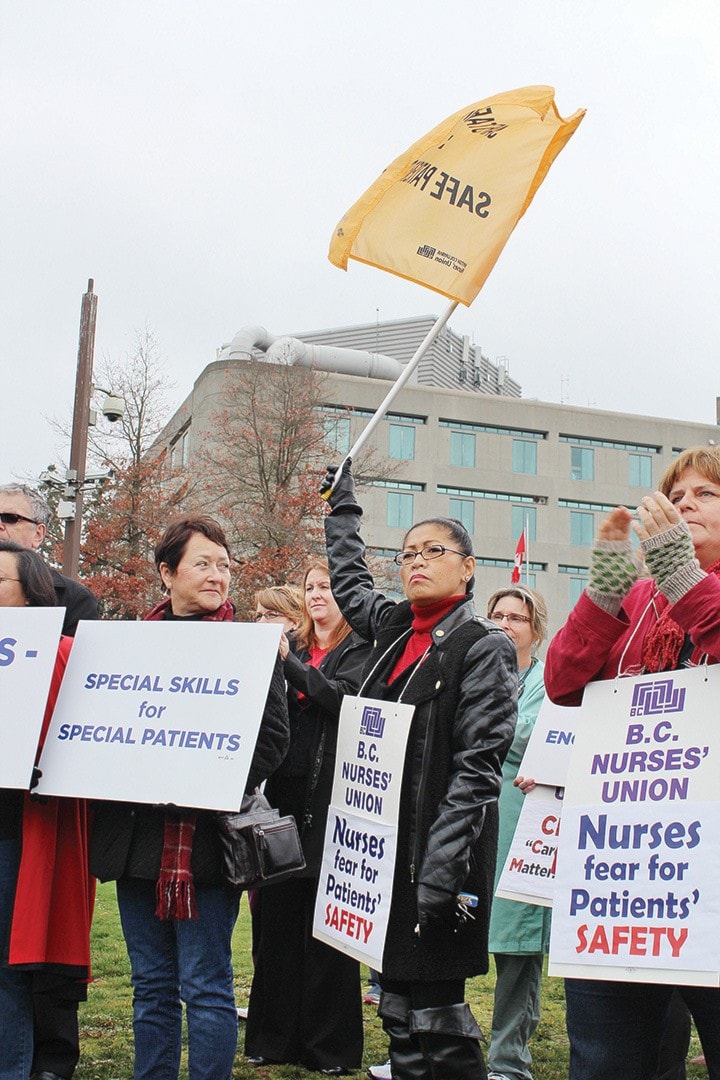To combat spiralling health care costs and overworked registered nurses, Island Health is revamping its patient care model at Vancouver Island hospitals.
In April, Island Health plans to transfer a number of acute-care nursing tasks to care aides at Victoria General and Royal Jubilee hospitals, after the model was implemented at Nanaimo Regional Hospital last September. The B.C. Nurses’ Union staunchly opposes this move, which it argues will result in lower quality patient care.
In the first of our three-part series, The News explores why Island Health believes this new care delivery model is necessary, and why the nurses’ union is adamantly opposed.
* * *
Island Health plans to reduce chronic overtime worked by RNs by introducing health care assistants, or care aides, into acute care under a system called care delivery model redesign.
Acute care includes patients in emergency and those recovering from illness, injury or surgery. Under the new model, the feeding, bathing and toileting of patients will fall to care aides rather than nurses.
Victoria’s two main hospitals were meant to restructure patient care services in January, but that deadline has been pushed to April after a rocky rollout at Nanaimo Regional General Hospital in September.
“The transition (has) been challenging for staff, both in Nanaimo and Victoria, in the leadup to the change,” said Island Health spokesperson Sarah Plank.
Care aides are already integrated into acute patient care at smaller Island hospitals, including Port Alberni, Cowichan and Campbell River, which have smaller staff and lack many speciality units.
Nanaimo has seen challenges integrating the work flow of nurses and care aides in acute care wards. The BCNU argues patient care has gone downhill since the redesign was implemented in Nanaimo. Registered nurses are now managing a larger team of health care providers to oversee an increased volume of patients, said BCNU president Debra McPherson.
The result is less direct contact between nurses and acute care patients, where nurses can notice subtle changes in patient wellness during feeding, toileting and bathing, McPherson said. The union wants Island Health to hire more RNs, rather than care aides, to ease the workload.
“The delay is just (Island Health) trying to have some more time to convince nurses that (the new model) is a good thing, and they just won’t be able to do this,” she said.
“They are facing resistance from nurses and it’s time to get rid of it.”
McPherson notes that Island Health is delaying the rollout of the new care model in Victoria due to a lack of care aides.
“Colleges aren’t churning out care aides fast enough,” McPherson said. “It’s going to be really interesting, throwing these very inexperienced members into very busy acute care units in Victoria.”
In Part 2, stakeholders weigh in on their hopes, fears and expectations with the pending patient care changes.
editor@vicnews.com
Nursing levels by the numbers
• Camosun College offers a 29-week, full-time program to become a health care assistant. A licensed practical nurse requires two years of school and a registered nurse requires four years.
• Between August 2012 and August 2013, nurses Island-wide worked 268,136 hours of overtime at a cost of $17.6 million. Sick time totalled 511,700 hours at a cost of $14.37 million, according to Island Health.
• Per hour, health care assistants earn between $20.81 to $23.54, licensed practical nurses earn $24.74 to $27.32 and registered nurses earn $31.71 to $41.63.
